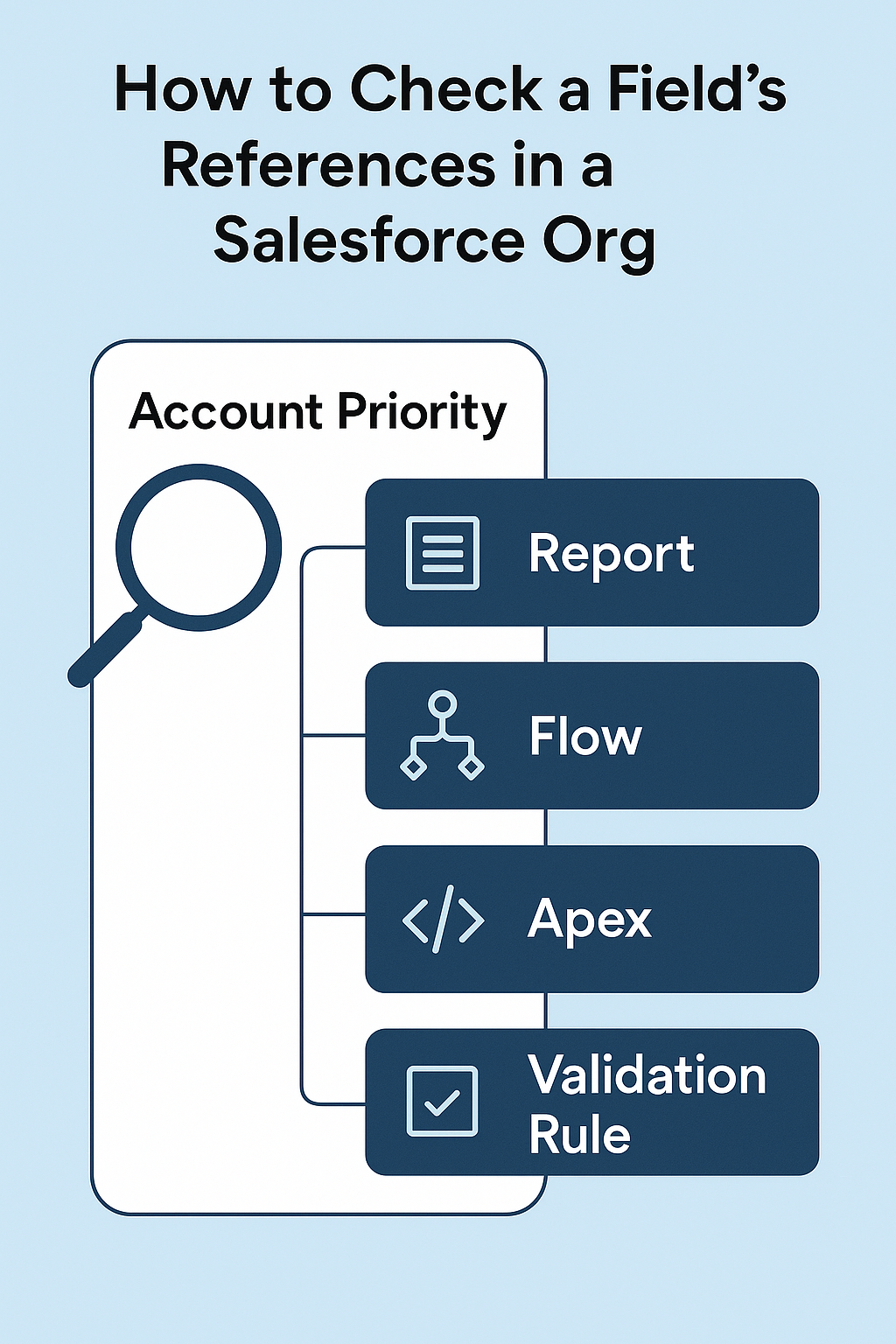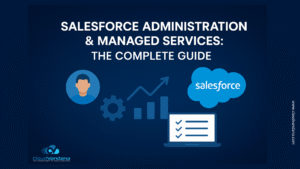Learn how to check where a Salesforce field is used across reports, flows, Apex, and automations. Discover tools and best practices for field reference tracking to ensure safe changes and maintain org integrity.
Introduction
Every Salesforce field serves a purpose—but that purpose can become obscured over time. As organizations grow and evolve, fields are added, modified, repurposed, and sometimes forgotten. The danger arises when those forgotten fields are still in use—in validation rules, reports, flows, and automations—making cleanup a risky proposition.
Understanding where a field is used, referenced, or embedded is critical to ensuring system integrity and avoiding unintended disruption. This article explores how to comprehensively trace a field’s references and identify reports using it.
Why Field Traceability Matters in Salesforce
Salesforce is a relational database, and fields are often tightly interwoven into the logic, automations, and reports that drive your business. Removing or altering a field without full visibility into its dependencies can create cascading errors—breaking workflows, corrupting data, or halting user activity.
Traceability is also vital during mergers, audits, refactoring, or transitions from Classic to Lightning Experience.
Common Scenarios Where Field Reference Checks Are Essential
Field reference checks are not just for cleanup. They are mission-critical in several scenarios:
- Field Deletion or Deprecation: Before removing a field, you must identify every rule, report, or component that uses it.
- Field Renaming: Although labels can be updated easily, their meaning might be deeply embedded in automation logic.
- Field Reuse: Repurposing an underutilized field demands a clean slate—free of legacy references.
Understanding Metadata Dependency in the Salesforce Ecosystem
Salesforce metadata defines how components relate to one another. Fields are referenced not just in record pages but in formulas, workflows, Apex logic, and dashboards. They are part of the metadata layer, which dictates configuration behavior.
Understanding dependencies across metadata types ensures you don’t break interconnected systems with a seemingly small change.
What Happens When You Change or Delete a Field
Deleting a field in Salesforce doesn’t just remove a column from your data—it can:
- Break Apex classes
- Nullify formulas
- Disable process flows
- Invalidate reports
Salesforce may stop you from deleting some in-use fields, but not all dependencies are caught at runtime. Silent failures or misbehaving logic may result.
Overview of Tools Available for Reference Checking
Salesforce admins and developers have a mix of native tools, APIs, and third-party platforms to audit field references. Each tool comes with its own benefits, and often a combination is necessary for complete visibility.
Options include:
- Setup search
- “Where is this used?” native tools
- Metadata API
- Workbench
- SOQL
- Third-party analyzers
Using Setup Search to Locate Basic Field Usage
The simplest place to start is Salesforce’s Setup interface. Searching a field name via Setup will return metadata that mentions it—like validation rules, formula fields, or page layouts. While helpful, this method is not exhaustive.
Setup search works best for direct references—not for embedded or indirect logic calls.
Explore Where a Field Is Used: Native Salesforce Feature
Salesforce recently introduced the “Where is this used?” feature for custom fields. It displays:
- Page layouts
- Formula fields
- Validation rules
- Apex triggers
Though not available for all metadata types yet, it’s a powerful baseline tool—especially for newer orgs using custom fields extensively.
Limitations of Native Tools and the Need for Precision
Native tools offer snapshots, not full audits. They don’t scan:
- Reports using the field
- Custom metadata references
- External integrations or ETL scripts
- JavaScript buttons or embedded Visualforce pages
For full coverage, you’ll need metadata APIs or specialized tools.
Checking Field Usage in Validation Rules
Validation rules frequently reference fields in formula expressions. Open your Object Manager > Validation Rules and inspect each rule for:
- Direct field names
- Conditional logic using the field
- Error messages that imply field validation
A broken reference here will silently disable enforcement.
Identifying Field Usage in Workflow Rules and Flows
Workflow rules and process builders often use field values in criteria or actions:
- Field X = True → send email
- Field X updated → create task
Use Flow Explorer or debug logs to surface hidden dependencies. Even paused flows may contain critical references to older fields.
Tracing References in Apex Classes and Triggers
Apex code is a common sink for field usage. Developers may hardcode field names into queries, comparisons, or DML statements.
Use:
- Setup > Apex Classes
- Developer Console global search
- VS Code with Salesforce CLI
Look for any field name string or dynamic reference.
Field Dependencies in Process Builder and Flow Builder
In Flow Builder, field references exist in:
- Decision nodes
- Assignment elements
- Record triggers
- Screen components
Field renaming or deletion can crash flows silently or skip actions. Downloading the flow’s metadata can expose hidden dependencies.
Finding Reports That Use a Specific Field
Reports often mask field dependencies because their metadata is stored separately from object logic. To uncover this:
- Identify custom report types that include the field
- Run export queries using Report API
- Scan report columns and filters manually
Even one filtered report using a deprecated field can distort analytics.
Using “Report Type” Metadata to Locate Field Usage
Each report is tied to a report type. If your field is part of a custom report type, reports created from it may include or reference the field. Start by reviewing:
- Object relationships in the report type
- Field accessibility
- Dependent filters
This helps narrow your report audit scope.
Manually Searching Reports for Field Presence
If metadata tools aren’t available, go manual:
- Create a report on reports
- Add filters for “Last Run Date,” “Report Type,” and “Modified By”
- Open reports that use the target object or field name in filters/columns
Slow but effective for limited audits.
Building a Custom Report on Report Metadata (via Report API)
Use Salesforce’s Report Metadata API to programmatically extract report definitions:
- Report name
- Columns used
- Filters applied
- Summary logic
With a simple script, you can pull all reports using a specific field—even if it’s not visible in the UI.
Automating Field Reference Audits with Metadata API
The Metadata API is the most reliable way to scan your org at scale. It exposes:
- References in Apex
- Usage in custom settings and metadata
- Flow and process references
Export metadata as XML, then parse it for your field name using scripting languages like Python or Node.js.
Using Workbench to Analyze Field-Level References
Workbench is a Salesforce admin’s Swiss Army knife. Log in and navigate to:
- Metadata > Retrieve
- Use “Search Metadata” to locate field dependencies
- Review component names and types referencing the field
Workbench doesn’t always show usage context but offers a fast way to audit object-level metadata.
Field Usage Analysis in Third-Party Tools (e.g., Gearset, Elements.cloud)
Enterprise-grade tools like Gearset and Elements.cloud provide:
- Impact analysis
- Visual field maps
- Cross-object dependency charts
- Report-level field analysis
These platforms are ideal for large orgs with complex environments and frequent metadata changes.
Best Practices for Documenting Field Relationships
Start a field dependency map:
- Which reports use the field
- Which automations depend on it
- Where it’s referenced in code
- When it was created and by whom
Use spreadsheets, diagrams, or dedicated metadata documentation tools.
Role of Field Descriptions and Help Text in Traceability
Use the Description and Help Text fields wisely. Add:
- Field purpose
- Key dependencies
- Business logic notes
- Creator info
This reduces future guesswork and helps downstream teams understand the field’s context.
How to Use Custom Metadata to Map Critical Fields
Create a custom metadata type called “Field Registry”:
- List field API name
- Used in automation?
- Used in reports?
- Retired?
Now every admin or developer has access to live documentation inside Salesforce.

Field Usage Logs and Change History Considerations
Use Field History Tracking or Field Audit Trail to monitor:
- Whether the field is being updated
- Who is using it
- When it last had a value
Inactive fields with no updates in months may be candidates for retirement—if references are removed.
Preventing Orphaned Fields During Org Cleanup
Before deleting any field:
- Check all references
- Remove or replace usage
- Notify downstream users
- Update documentation
Use change sets or dev sandboxes to test deletions before pushing live.
Establishing a Field Lifecycle Management Strategy
Field creation should be intentional. Adopt a lifecycle approach:
- Proposal
- Approval
- Implementation
- Usage review
- Retirement
Tag unused fields and set review reminders every 6–12 months.
Tips for Refactoring Fields Without Breaking References
When cleaning up or merging fields:
- Create new fields instead of repurposing old ones
- Use Flows to migrate data
- Update all dependent automations
- Test thoroughly in full-copy sandbox
Proper refactoring reduces tech debt and improves system health.
Security and Permission Considerations When Auditing Fields
Some users may not see or access specific fields due to FLS or profiles. When conducting audits:
- Use a system administrator profile
- Ensure full object visibility
- Watch for false negatives due to hidden fields
Security settings can obscure actual usage patterns.
Field Reference Audits in Managed Packages and ISV Contexts
ISV packages have unique considerations:
- Field names are namespaced
- Metadata is partially locked
- Documentation may be limited
Use subscriber support tools and partner APIs to extract dependencies before making changes.
Conclusion: Building a Safer, Smarter Org with Field Awareness
Fields are more than just data points—they’re threads woven into the fabric of your org. Before changing or deleting any field, it’s essential to trace its footprint across your system. From flows to Apex, reports to metadata, visibility into field usage helps maintain data integrity, platform performance, and business continuity.
With the right tools, habits, and audit practices, you can build a Salesforce org that is not just functional—but resilient, scalable, and ready for whatever change comes next.
At CloudVandana, we help Salesforce teams take control of their metadata with clarity and confidence. Whether you’re auditing field usage, refactoring legacy automations, or planning a cleanup initiative, our certified Salesforce experts deliver solutions that prevent disruption and enhance system reliability.
From custom automation strategies to deep metadata analysis, we ensure every field in your org is purposeful, traceable, and aligned with business goals. If you’re ready to streamline your Salesforce instance and eliminate field-related risks, CloudVandana is here to guide you—every step of the way.
















